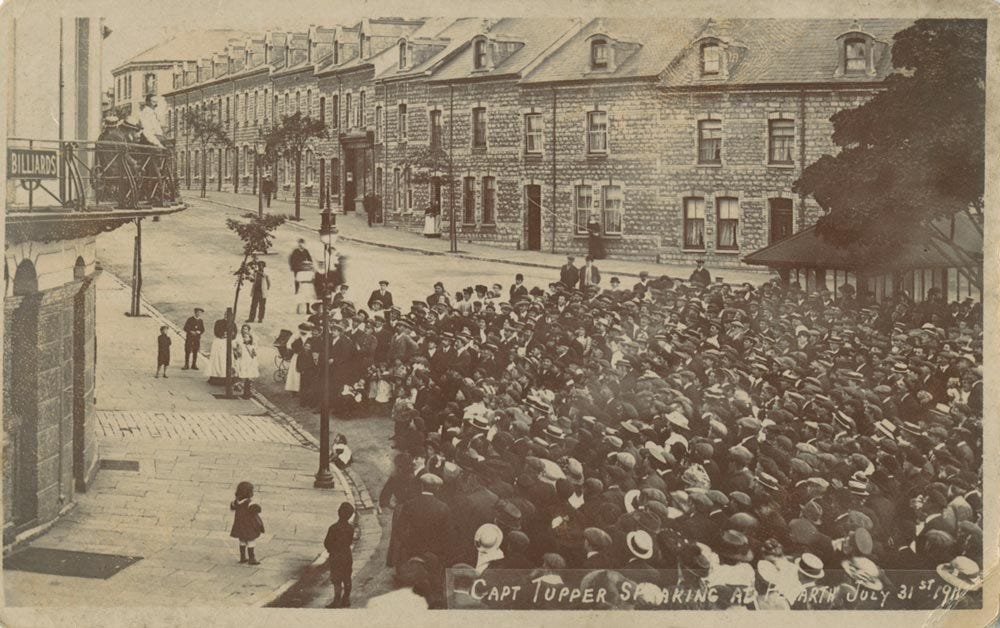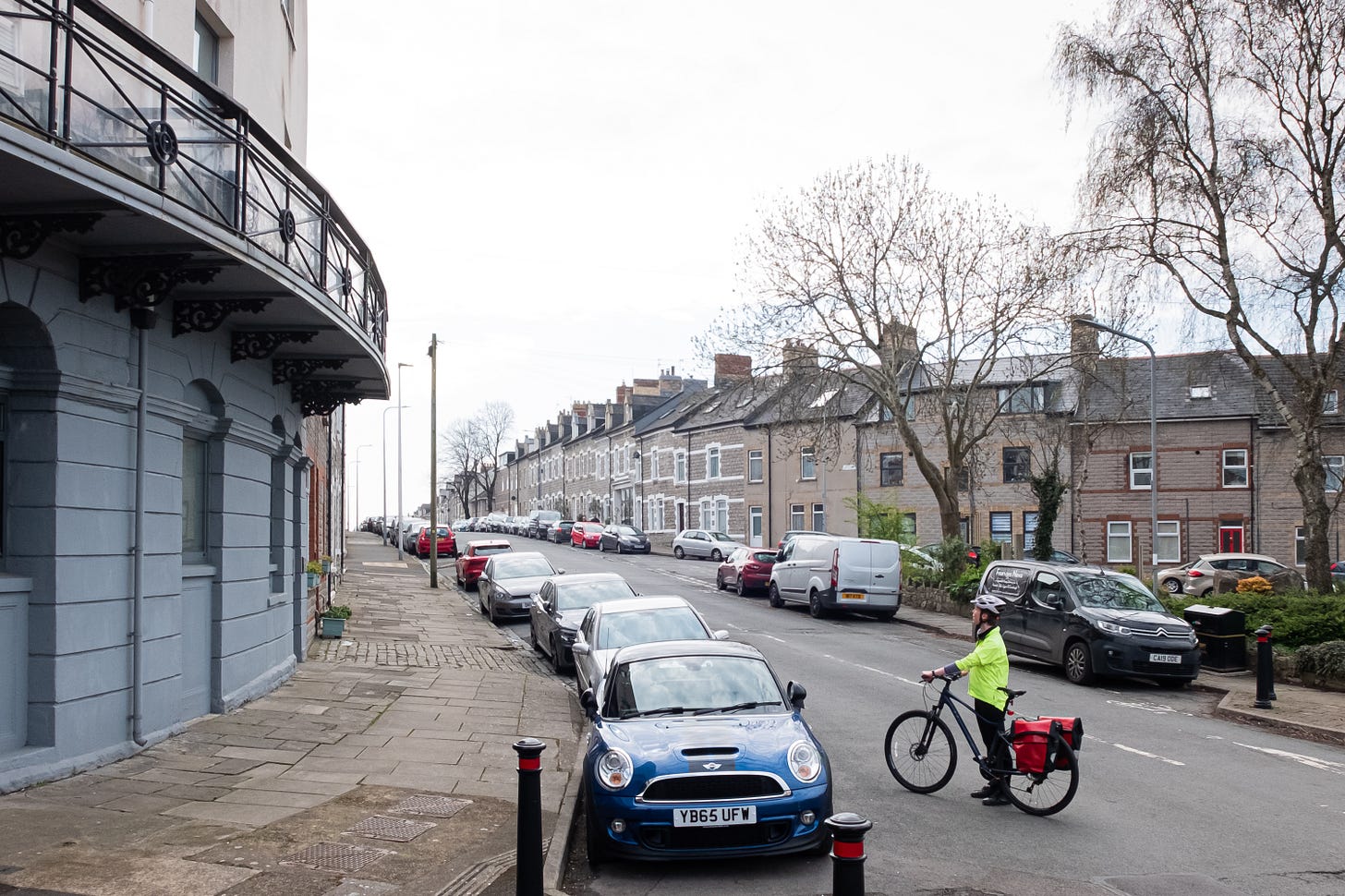Workers’ rights, racism and extreme weather: Wales’ forgotten strike
Claire Boot explores how the long-forgotten Seaman's Strike of 1911 intersects with her personal landscape of South Wales
There’s a small triangle of land on the brim of the ridge that defines Penarth. Its apex points towards the town’s high street; its base faces the steep drop to the edge of Cardiff Bay. Arcot Triangle, named for the street that splits in half to form it, is a pleasant patch of trees and flowers cared for by volunteers. There are tall wooden bee hotels and short white flagpoles. A noticeboard explains the school project that embedded metal motifs of sailors’ tattoos into the stones standing in the middle of the seating area. I cycle along Arcot Street twice a day commuting between my home, on the southwestern side of Penarth, and my workplace, east of Cardiff’s city centre. Every time I pass Arcot Triangle, I think of Captain Tupper.
Captain Edward Tupper V.C. was neither a captain nor a recipient of the Victoria Cross – although it suited his purposes to let people believe he was both. He arrived in Cardiff in May 1911 as an organiser for the National Sailors’ and Firemen’s Union (NSFU), which was on collision course with shipowners, as represented by the Shipping Federation. The economy depended on the men who worked the steamships, but life at sea was harsh. Sailors typically worked shifts – four hours on, four hours off – for little more than £1 a week and no overtime pay. They supplied their own clothing and bedding, and ate whatever rations were provided. The NSFU pushed for the establishment of a conciliation board to discuss sailors’ pay and working conditions, with no success. According to a socialist pamphlet published at the time: ‘Shipowners paid no attention to the request, and the Shipping Federation ridiculed it.’
In response, the NSFU declared a strike on June 14, 1911. British shipping stopped. From Liverpool, Newcastle and Hull to Swansea, Southampton and London, ports were paralysed. Delayed cargo piled up on the wharves. Planned shipments never arrived. With industrial action spreading to Belgium, the Netherlands and the USA, the Seamen’s Strike of 1911 has a claim to being the world’s first international strike.
Captain Tupper’s contribution to the cause lay in delivering thunderous speeches that denounced the shipowners and delighted the strikers. A photograph (above) from July 1911 captures Tupper in action at Arcot Triangle. He stands on the balcony of the Royal Hotel, addressing a large crowd of men, women and children in a dense sea of straw hats and flat caps.
The street scene is still easily recognisable today. The Royal Hotel is now apartments but the building retains its distinctive curve and metal balcony rails. You can identify the houses in the background and pick out the trees in the triangle. Every time I cycle past, I see Tupper on the balcony and hear the cheers and jeers of the crowd. It makes me realise that as we move through places, places move through us too.
Tupper’s style was high in drama if low on fact. One account describes how he waved a blank sheet of paper at a crowd in Butetown, declaring he had evidence of a local shipowner’s ‘disgraceful love affairs’ that he was tempted to make public. His rhetoric also contained a vicious racist streak. Sailors willing to crew ships despite the strike were branded ‘blacklegs’ and Tupper singled out Chinese seamen for particular abuse. In a derogatory racist slur, he termed them ‘the yellow flotsam and jetsam of the Bristol Channel.’ A month after the strike started, Tupper’s words incited a dangerous riot that engulfed a ship moored in Cardiff’s Roath Basin.
I pass Roath Basin on my daily cycle route, after I’ve freewheeled down to Penarth Marina and pedalled across the barrage. As a child, I remember visiting the white tubular Cardiff Bay Visitor Centre that stood alongside the basin’s original entrance. To me, it looked like a giant squashed toilet roll, and I was fascinated by the large three-dimensional map of Cardiff inside. It gave a vision of the future, with a new sea wall snaking across the estuary and little block buildings and trees like lollipops along the edge of a permanent high tide. Next to the ‘Tube’, the bright red Lightship was moored in the basin. Half-boat, half-lighthouse, the vessel had been converted into a Christian centre with a café and meeting rooms. While temping in offices nearby in my twenties, I used to escape the corporate world at lunchtime by boarding the Lightship for a cup of tea and a couple of Welsh cakes.
Roath Basin was not the place for a quiet cycle or a Welsh cake in the July of 1911. Hot weather stoked the frustrations of strikers struggling with no pay and no resolution in sight. In a fiery speech outside the dock gates, Tupper announced that a ship berthed in Roath Basin had taken on Chinese sailors. He called for volunteers to form a picket. Some six hundred men swarmed into the docks. They stormed the ship, surging up the gangway and spilling on to the deck. Police, strikers and sailors were embroiled in fighting until Tupper turned up and called off the mob. In an adroit switch from rabble-rouser to peacemaker, he declared: ‘It is not blood we want, but the places of the Chinese on this boat!’
The threat to Chinese sailors spread to Barry, itself a major coal-exporting port to rival Cardiff. On June 28, the South Wales Daily News reported that a mass meeting heard how ‘London had been raked and scraped from one end to the other to get Chinese sailors.’
When thirteen Chinese firemen arrived in Barry, accompanied by twelve police officers, they were met at the dockside by a demonstration several hundred strong. In the chaos at No. 3 tip, the strikers tried to stop coal from being loaded on to a ship while the Chinese sailors barricaded themselves below deck for safety.
A remarkable photograph from 1911 shows a group of Chinese seamen walking down Subway Road towards Barry Docks with a police escort. I’ve cycled past Subway Road many times on my way to Barry Island and it takes no imagination to visualise the men on the road, with the railway bridge behind them. It takes a little more effort to mentally screen out the new apartment blocks and urban landscaping; the docks in Barry, as in Cardiff and Penarth, are undergoing a transformation from industrial to residential.
In the middle of the redevelopment is The Bridge Between Community Centre, a brand-new facility with an award-winning community garden. It’s also home to Lana’s Café, run by a self-advocacy group for adults with additional needs. By chance, I drop in during one of their weekly ‘Warm Spaces’ sessions and I’m treated to delicious homemade tomato soup with a bread roll and cup of tea, all free of charge. The centre is bright and warm, friendly and welcoming. As I sip my tea amongst the chatter of the café customers, it’s a curious thought experiment to recall the divisive mayhem at No. 3 tip, half a mile and a hundred years away.
Even Penarth Pier, that genteel symbol of Edwardian seaside promenading, was drawn into the strike. To avoid dockside battles with picket lines, the Shipping Federation moored an old supply ship, Lady Jocelyn, off Penarth Head. Boatmen with small craft, usually engaged in ferrying daytrippers across the Bristol Channel, were paid to discretely take sailors from the mainland to Lady Jocelyn, from where they could join steamships out at sea. Unsurprisingly, this arrangement enraged Captain Tupper. On July 13, he railed:
Last night a tug boat took Chinamen from Penarth Pier to Lady Jocelyn… that dirty slave dhow. I should like to meet the tug-owner. I’d fight him for fifty quid right here.
The crowd took him at his word. They marched on the Butetown offices of the tugboat owner, Edmund Handcock, which led to smashed windows and clashes with police. Tupper was arrested for disturbing the peace by causing ‘terror and alarm’. His arrest instigated further rioting. On July 20, warehouses were looted and burned, and Chinese-owned laundries and boarding-houses were attacked.
I grew up in Penarth and my earliest sense of geography includes the pier, the headland and the bay before the barrage. In the eighties, my parents kept a 24-foot yacht on moorings in the Ely River. It was called Bootlace, in a nod to our unusual surname, and when the tide, weather and timing were right, we would sail out into the Bristol Channel.
I was too young to be much use as a deckhand, but I knew to swiftly duck down whenever Dad yelled, ‘Ready about, lee-ho!’ and the boom swept the sail over our heads and across the wind. I remember the complicated drive through former industrial sites and past the old Red House pub to the moorings, before Ikea or the Butetown Link Road were built. I remember the smell of the glistening mud, crisscrossed with jetties and ropes and bird tracks.
My family continued to be connected with boats; my parents later owned a canal boat, my brother became a naval architect, my sister rowed at university, and I lived onboard a hospital ship for over a year.

The Seamen’s Strike was settled on July 28, 1911, to the satisfaction of the NSFU. Tupper came out of it well. At his trial two months later, he used his oratorial abilities to successfully represent himself and was acquitted of all charges. He continued to work for the NSFU and published his autobiography, Seamen’s Torch, in 1938.
Although momentous at the time, the Seamen’s Strike has been relegated to a few archive photographs, old newspaper articles and obscure academic journals. Why was it forgotten? Perhaps it was due to its timing, only three years before the First World War gouged a hole in early twentieth century history. Certainly it was dwarfed by later industrial disputes. It had neither the scale of the General Strike in 1926, which involved over 1.5 million workers, nor the seismic social impact of the year-long Miners’ Strike from 1984 to 1985.
If Captain Tupper, the sailors and the shipowners joined me on Penarth Pier today, they would recognise the cliffs and the coastline, the mudflats and the sandbanks, the headlands and the islands. But they would be astonished by the water.
The Bristol Channel, crowded with vessels for centuries, has few ships or boats on it now. We’re far removed from that hot summer in 1911 when a shipping crisis stopped the export of the world’s most wanted fuel for six tumultuous weeks. But, like the landscape, some features remain the same. A century later, we’re still dealing with workers’ rights, racism, and extreme weather. Like all who have gone before us, and all who will come after us, we layer the landscape with our lives, and the landscape layers our lives too.
Claire Boot is a writer from Penarth. She has worked with Literature Wales, Sherman Theatre and Honno.






